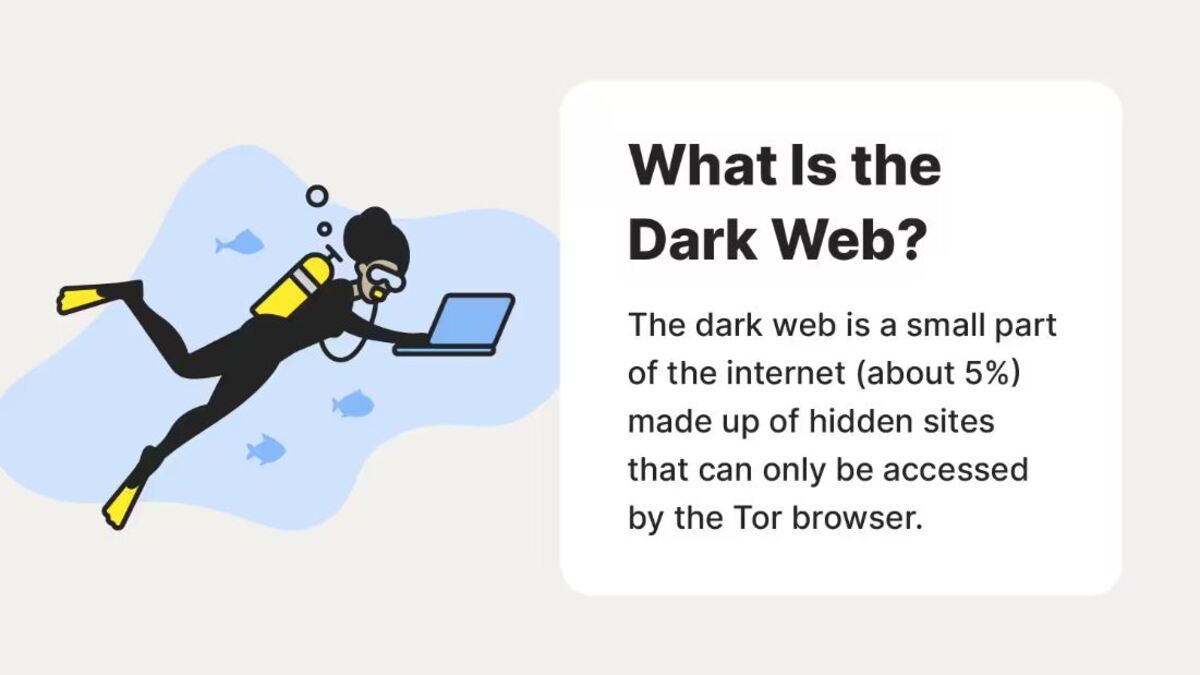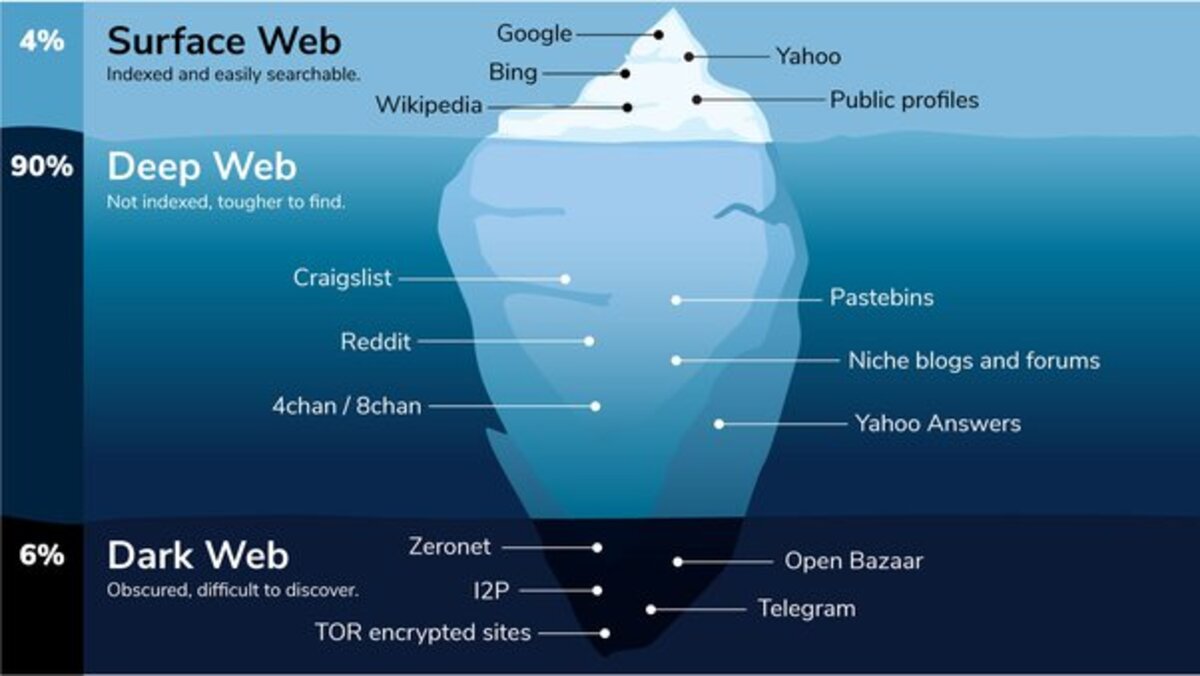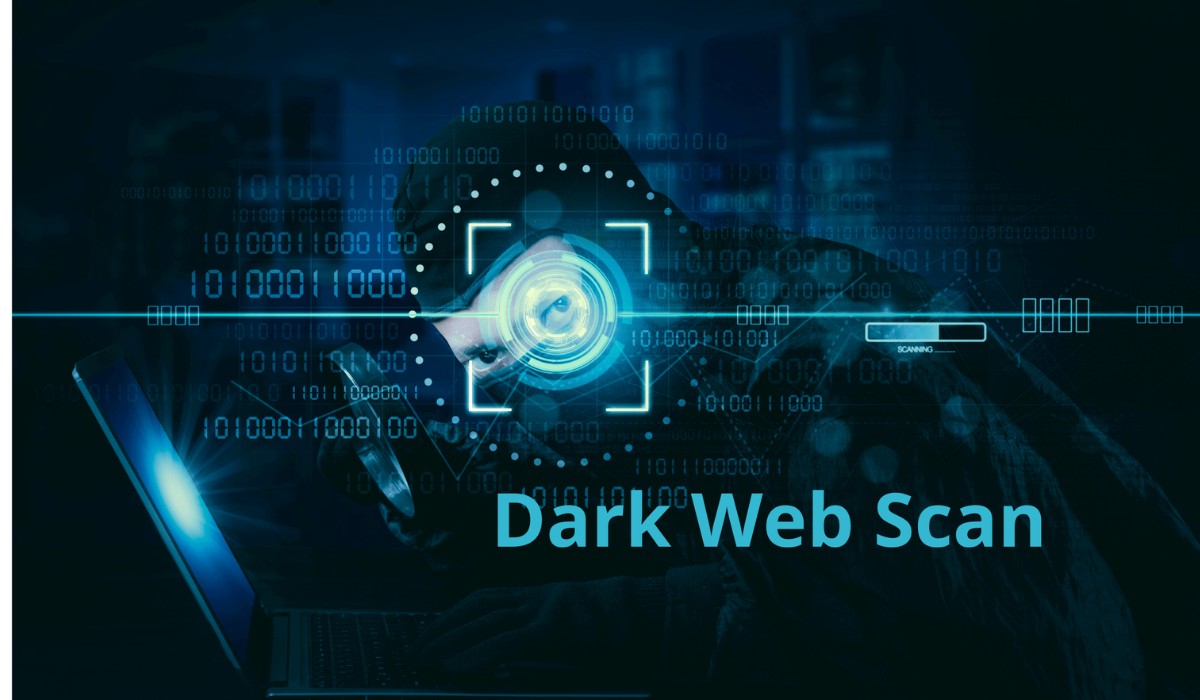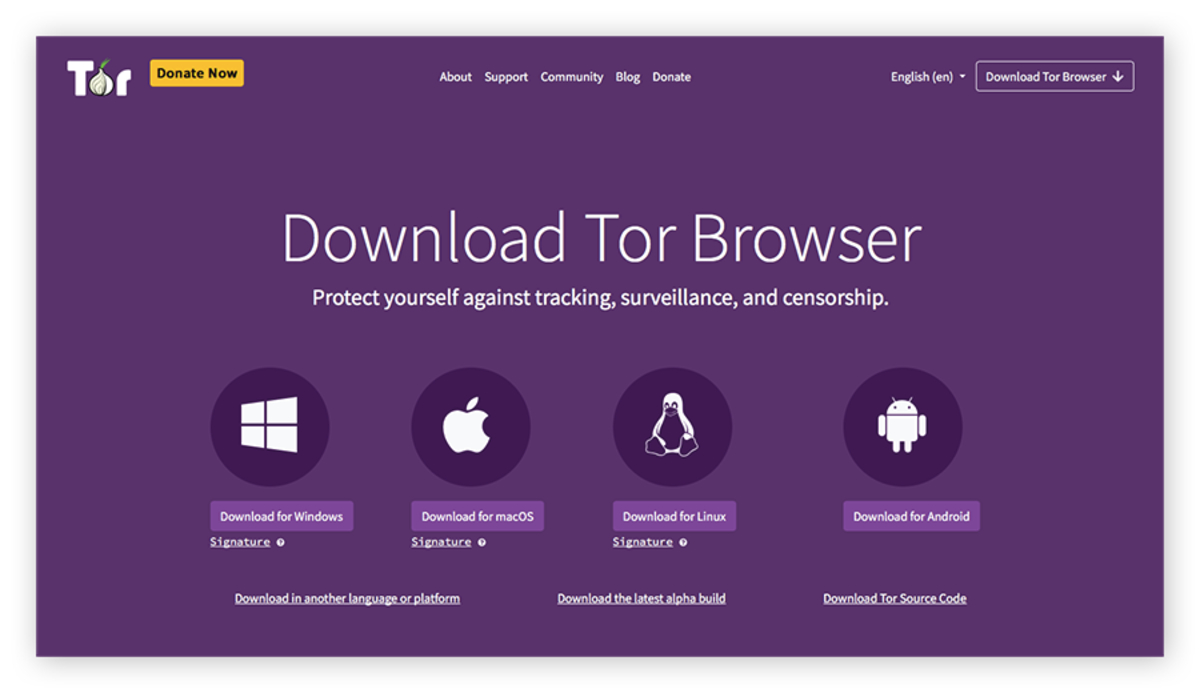Introduction
Welcome to the mysterious world of the Dark Web. In a time when our lives are increasingly connected through the internet, it’s important to understand the hidden underbelly that exists beneath the surface. The Dark Web, often shrouded in secrecy and associated with illegal activities, is a part of the internet that is not indexed by search engines and requires specific software to access.
While the surface web, the realm of everyday browsing and search engine results, represents only a fraction of the internet, the Dark Web is estimated to be much larger, serving as a hub for both legal and illicit activities. But what exactly is the Dark Web, and how does it work?
In this article, we will delve into the definition of the Dark Web, explore how it operates, examine the Tor browser, which is commonly used to access it, and discuss the types of content that can be found within its depths. We will also highlight the potential dangers and risks associated with venturing into this hidden realm, as well as provide some tips on staying safe while exploring the Dark Web.
Before we embark on this journey, it’s essential to note that the purpose of this article is purely informative. It is not intended to encourage or promote illegal activities or provide a guide on how to access the Dark Web. Rather, it aims to shed light on this intriguing and often misunderstood part of the internet.
Definition of the Dark Web
The Dark Web refers to the hidden part of the internet that is not indexed by traditional search engines like Google, Bing, or Yahoo. It can only be accessed through specific software and configurations, which grant users anonymity and allow them to navigate the Dark Web without revealing their identity or location.
Unlike the surface web, which includes websites that are easily accessible through standard web browsers, the Dark Web is intentionally concealed from public view. It is composed of various encrypted networks and private connections, making it challenging for authorities to trace or monitor activities that take place within its boundaries.
One distinction to be made is that the Dark Web is not synonymous with the deep web, although the two terms are often used interchangeably. The deep web refers to all the web pages that are not indexed by search engines, including password-protected sites, subscription-based content, and personal email inboxes. Conversely, the Dark Web specifically refers to the portion of the deep web that serves as a platform for anonymous and often illicit activities.
The primary technology that enables the existence of the Dark Web is called Tor (The Onion Router). Tor is an open-source software that encrypts and routes incoming and outgoing internet traffic through a network of volunteer-operated servers, or nodes, in order to mask the user’s IP address and enhance anonymity.
Now that we have a basic understanding of what the Dark Web is, let’s explore how it works and what kind of content can be found within its hidden realms.
How Does the Dark Web Work?
The Dark Web operates on a network known as Tor, which stands for The Onion Router. This network is designed to provide users with anonymity and privacy by encrypting their internet traffic and bouncing it through multiple servers around the world. This routing process gives the network its name, as it is analogous to the layering of an onion.
When a user accesses the Dark Web, their connection is routed through a series of Tor nodes, each one decrypting a layer of encryption applied to the data. This layered encryption ensures that no single point in the network can identify both the sender and the recipient of the information, making it extremely difficult to track or trace the user’s online activities.
While traditional websites on the surface web have easily identifiable domain names like .com or .org, Dark Web addresses are in the form of a series of random characters, making them much more challenging to remember or access without the assistance of software specifically developed for this purpose.
The most common software used to access the Dark Web is the Tor browser, which is built on the same principles as the Tor network. The Tor browser connects to the Tor network and allows users to browse Dark Web websites anonymously. It automatically encrypts the user’s data and routes it through multiple nodes, ensuring their online activities remain concealed.
It’s important to note that while the Tor browser provides anonymity, it is not foolproof. Law enforcement agencies and advanced cyber attackers can still employ various techniques to identify users or compromise their anonymity. Therefore, caution should always be exercised when exploring the Dark Web.
Additionally, it’s worth mentioning that the Dark Web is not entirely hidden from public view. There are some specialized search engines, forums, and directories that catalog and index certain parts of the Dark Web, making it slightly more discoverable. However, accessing these resources and navigating the Dark Web still requires specific knowledge and tools.
Now that we have a basic understanding of how the Dark Web operates, let’s dive into the types of content that can be found within its hidden corners.
Understanding Tor Browser
The Tor browser is a critical tool for accessing the Dark Web securely and anonymously. It is a modified version of the Mozilla Firefox web browser that is specifically designed to work with the Tor network. The Tor browser is available for Windows, Mac, Linux, and Android devices.
When you use the Tor browser, your internet traffic is routed through multiple Tor nodes, making it nearly impossible to trace back to your original location. This level of encryption and anonymity is achieved through a complex process of rerouting your data through different nodes and encrypting it at each step, ensuring that your online activities remain private.
Using the Tor browser is relatively straightforward. Once downloaded and installed, you simply open the browser and connect to the Tor network. The browser takes care of routing your connection through the Tor nodes automatically, without requiring any additional configuration.
It’s important to note that the Tor browser is not limited to accessing the Dark Web. While it is commonly associated with accessing hidden websites, it can also be used to browse the surface web securely and anonymously. This can be useful in situations where privacy and anonymity are a concern, such as when accessing sensitive information or communicating in regions with restricted internet access.
However, it’s crucial to exercise caution when using the Tor browser, especially when accessing the Dark Web. While the browser provides anonymity, it does not guarantee complete security. Malicious actors can still exploit vulnerabilities in the browser or use other techniques to compromise your online privacy.
It is advisable to take additional precautions when using the Tor browser, such as disabling JavaScript, regularly updating the browser to the latest version, and being mindful of the websites you visit. Additionally, it’s crucial to be aware that accessing certain websites on the Dark Web may expose you to illegal or harmful content.
Now that we have a clearer understanding of the Tor browser and how it enables access to the Dark Web, let’s explore the types of content that can be found within this hidden realm.
What Can You Find on the Dark Web?
The Dark Web is a vast and sometimes unsettling place, hosting a wide array of content that spans both legal and illegal activities. While it is often associated with illicit markets and underground forums, it’s essential to note that not everything on the Dark Web is illegal or harmful. Let’s explore some of the types of content you can find within its hidden corners.
1. Marketplaces: One of the most well-known aspects of the Dark Web is its underground marketplaces. These platforms offer a wide range of illegal goods and services, including drugs, firearms, counterfeit documents, stolen data, and hacking tools. These marketplaces often operate using cryptocurrencies like Bitcoin to ensure anonymity in financial transactions.
2. Whistleblower Platforms: The Dark Web also provides a space for individuals to share sensitive and classified information without fear of reprisal. Whistleblower platforms, such as SecureDrop, allow users to submit anonymous tips and leaks to journalists and organizations, protecting their identities and ensuring the information reaches the intended recipients safely.
3. Privacy Tools: The Dark Web is home to various privacy-centric tools and services. These include encrypted email providers, virtual private networks (VPNs), and secure messaging platforms. Privacy-conscious individuals and activists often rely on these tools to communicate securely and protect their online identities.
4. Forums and Communities: Just like the surface web, the Dark Web has its own online communities and forums where individuals gather to discuss a wide range of topics. These forums may focus on technology, hacking, conspiracy theories, activism, or other niche interests. While some may engage in illegal activities, others serve as platforms for discussion and information sharing.
5. Information & Document Sharing: The Dark Web is also host to hidden wikis and document repositories that contain a vast amount of information on various topics. These resources may range from educational materials to guides on hacking, privacy, and security. However, it’s important to approach this information with caution, as not everything may be accurate or reliable.
6. Cryptocurrency Services: Given the anonymous nature of the Dark Web, cryptocurrency-related services are prevalent. These services may include cryptocurrency exchanges, escrow services, and even money laundering operations. Cryptocurrencies are often the preferred method of payment due to their difficulty to trace and track.
It is essential to be cautious and discerning when exploring the Dark Web. Engaging in illegal activities or accessing certain content can have serious legal and ethical implications. Remember that not everything on the Dark Web is what it seems, and maintaining digital hygiene and safety should always be a priority.
With an understanding of the types of content found on the Dark Web, we must now turn our attention to the dangers and risks associated with venturing into this hidden realm.
Dangers and Risks of the Dark Web
While the Dark Web offers anonymity and access to a wide range of content, it is essential to understand the potential dangers and risks that come with exploring this hidden realm. Here are some of the risks associated with venturing into the Dark Web:
1. Malicious Actors: The Dark Web is filled with individuals engaging in illegal activities. Hackers, scammers, and cybercriminals lurk in hidden corners, ready to exploit unsuspecting visitors. From phishing scams to malware-infected websites, users can easily fall victim to threats that compromise their personal information or even their devices.
2. Illegal Marketplaces: The Dark Web is notorious for its underground marketplaces that sell illicit goods and services. Engaging with these marketplaces can lead to involvement in illegal activities, potential encounters with law enforcement, and legal consequences. Purchasing illegal items or services can also lead to financial loss or harm.
3. Law Enforcement Monitoring: While the Dark Web provides a degree of anonymity, it does not guarantee absolute protection. Law enforcement agencies actively monitor activities on the Dark Web, searching for individuals engaged in illegal activities. Users who engage in criminal behavior may be subject to investigation, prosecution, and legal consequences.
4. Exposure to Harmful Content: The Dark Web hosts content that can range from disturbing to downright dangerous. Users may inadvertently access explicit or violent material that can cause psychological harm. It is essential to exercise caution and be mindful of the websites and content you encounter while exploring the Dark Web.
5. Financial Loss: Cryptocurrency transactions are prevalent on the Dark Web due to their anonymity. However, users are at risk of financial loss when engaging in these transactions. Scammers and fraudulent sellers are common, offering counterfeit goods or disappearing without delivering the promised products. Additionally, users may encounter payment systems designed to steal their cryptocurrency holdings.
6. Compromised Personal Information: When accessing the Dark Web, there is always a risk that your personal information could be compromised. This includes usernames, passwords, email addresses, and other identifying details. This information can be used for identity theft, sold on underground forums, or even used for targeted cyberattacks.
It’s important to approach the Dark Web with caution and skepticism. Engaging in illegal activities or accessing harmful content can have serious consequences. If you choose to explore the Dark Web, it is crucial to stay informed, use security measures such as VPNs and encryption tools, and exercise good judgment at all times.
Now that we have discussed the dangers and risks of the Dark Web, let’s explore the illegal activities commonly associated with this hidden realm.
Illegal Activities on the Dark Web
The Dark Web has gained a reputation for facilitating various illegal activities due to its anonymity and encryption features. While not all activities on the Dark Web are illicit, there are certain common illegal activities that are associated with this hidden realm:
1. Drug Trafficking: One of the most well-known illegal activities on the Dark Web is the sale and distribution of illegal drugs. Numerous underground marketplaces offer a wide range of narcotics, allowing users to purchase drugs anonymously and have them delivered discreetly to their location. Cryptocurrencies are commonly used for transactions, further enhancing anonymity.
2. Weapons Trade: The Dark Web is home to illicit arms markets where users can purchase a variety of firearms, ammunition, and other weapons. Through these marketplaces, individuals can acquire weapons without background checks or legal documentation, presenting a significant concern for public safety.
3. Identity Theft: The Dark Web hosts forums and marketplaces where stolen personal information, including credit card details, social security numbers, and login credentials, is bought and sold. This information can be used for identity theft, financial fraud, and other malicious activities, putting individuals at risk of financial loss and emotional distress.
4. Hacking Tools and Services: Underground forums on the Dark Web provide access to a plethora of hacking tools, tutorials, and services. Cybercriminals can enhance their skills and purchase hacking services such as distributed denial of service (DDoS) attacks, malware creation, and hacking tutorials for targeting specific systems or individuals, causing significant damage.
5. Child Exploitation: Disturbingly, the Dark Web is also home to explicit material involving child exploitation, including child pornography and trafficking. These activities not only exploit innocent victims but also contribute to a cycle of abuse. Law enforcement agencies worldwide actively monitor these platforms to combat the distribution and consumption of such illegal content.
6. Financial Fraud: Various forms of financial fraud thrive on the Dark Web, including credit card fraud, counterfeit currency, and money laundering services. Criminals offering these services exploit the anonymity of the Dark Web to target unsuspecting individuals and financial institutions, causing substantial economic harm.
It is crucial to reiterate that these activities are illegal and immoral. Engaging in or supporting these activities on the Dark Web can have severe legal consequences and contribute to societal harm. Law enforcement agencies are actively working to track and prosecute those involved in illegal activities on the Dark Web.
Now that we have explored the illegal activities associated with the Dark Web, let’s shift our focus to best practices for staying safe while exploring this hidden realm.
Staying Safe on the Dark Web
Exploring the Dark Web can be risky, but with the right precautions, you can minimize the potential dangers and protect yourself. Here are some best practices for staying safe while navigating the Dark Web:
1. Use VPN and Tor Browser: To enhance your anonymity and protect your identity, use a reputable virtual private network (VPN) in combination with the Tor browser. A VPN encrypts your internet traffic and masks your IP address, while the Tor browser routes your connection through multiple nodes, making it difficult to trace back to your original location.
2. Keep Your System Secure: Ensure that your device is well-protected with up-to-date antivirus and firewall software. Regularly update your operating system, browser, and security software to patch any vulnerabilities and protect against the latest threats.
3. Practice Digital Hygiene: Be cautious about the websites you visit on the Dark Web. Avoid clicking on suspicious links or downloading files from untrusted sources. Be mindful of the content you come across and exercise critical thinking to avoid scams, phishing attempts, or malicious content that may compromise your safety.
4. Avoid Personal Information: While maintaining anonymity is crucial, it’s equally important to avoid disclosing personal information on the Dark Web. Never share sensitive details such as your real name, address, phone number, or financial information. Assume that anything you encounter or share on the Dark Web could be potentially compromised.
5. Browse with Caution: Remember that the Dark Web is filled with illegal and harmful content. Use your judgment and be selective when exploring websites and forums. Avoid engaging in or supporting illegal activities, and report any suspicious or criminal content you may come across to relevant authorities.
6. Protect Your Cryptocurrency: If you engage in transactions using cryptocurrencies on the Dark Web, be cautious about the security of your digital wallets. Use reputable wallets and follow best practices for storing and securing your cryptocurrencies. Be aware that transactions are irreversible, and there is a risk of financial loss due to scams or fraud.
7. Regularly Update and Educate Yourself: Stay informed about the latest security threats, scams, and vulnerabilities on the Dark Web. Regularly update your knowledge about security best practices and evolving techniques used by malicious actors. Education is key to staying ahead and protecting yourself in this constantly changing landscape.
Remember, the Dark Web can be a dangerous place, and engaging in illegal activities can have serious consequences. Always prioritize your safety, follow the law, and use common sense when navigating this hidden realm.
Now that we have covered tips for staying safe on the Dark Web, let’s wrap up our exploration of the Dark Web.
Conclusion
The Dark Web remains a fascinating and enigmatic part of the internet, offering both opportunities and risks for those who venture into its hidden realms. It is a place where anonymity and privacy are valued, but it is also a breeding ground for illegal activities and harmful content.
Throughout this article, we have explored the definition and workings of the Dark Web, gaining insights into how it operates and the types of content that can be found within its depths. We have also discussed the dangers and risks associated with exploring the Dark Web, highlighting the importance of staying safe and protecting oneself from malicious actors and illegal activities.
While the Dark Web can be intriguing to explore, it is crucial to approach it with caution and responsibility. Engaging in illegal activities on the Dark Web can lead to severe legal consequences, financial loss, or harm to one’s personal and online security.
If you do decide to explore the Dark Web, it is essential to educate yourself on security best practices, use reputable tools like VPNs and the Tor browser, and exercise critical thinking when encountering content or engaging in transactions. Remember to prioritize your safety and be aware of the potential risks that come with delving into this hidden realm.
Finally, it is important to recognize that the purpose of this article is purely informative. It is not intended to promote or encourage illegal activities on the Dark Web. Rather, it aims to provide a deeper understanding of this hidden part of the internet and the measures one can take to stay safe while navigating its complexities.
With the knowledge gained from this article, you will be better equipped to make informed decisions and navigate the digital landscape responsibly. Remember to always prioritize your safety and the legal implications of your online activities, whether on the surface web or the mysterious Dark Web.

























